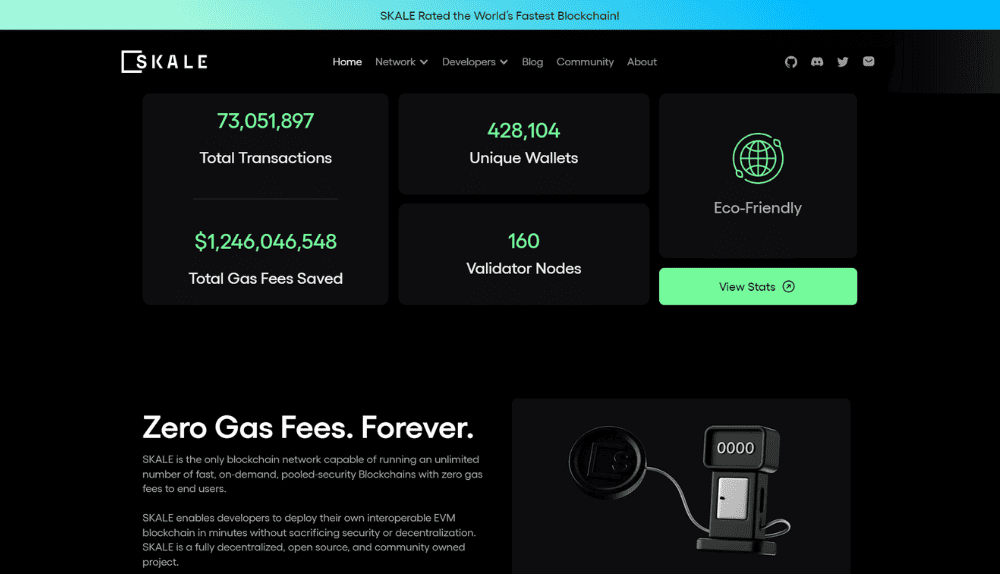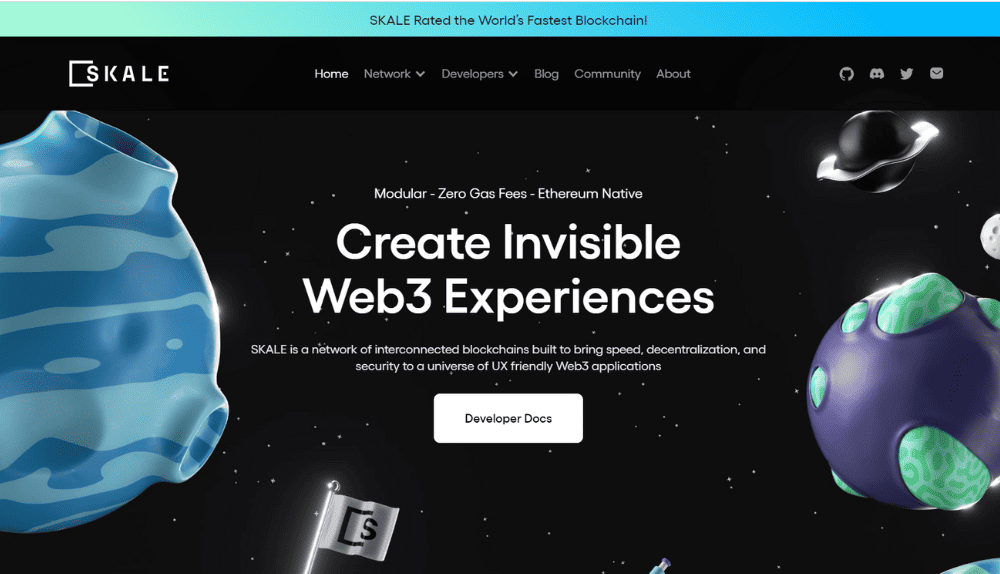Skale (SKL): Zero Gas Fee EVM Network
Ethereum is undoubtedly the most popular smart contract-capable platform that supports DApp development. A huge number of developers are now building DApps on this platform to serve the user. Currently, Ethereum is unable to handle the exponential growth of DApps. Therefore, the platform becomes congested when the transaction volume increases.
Skale is one of the leading layer-2 solutions designed to solve this problem. Skale uses an innovative mechanism to over the scaling problem while allowing users to enjoy the security of Ethereum.
What is Skale?
Skale is a layer-2 protocol built on Ethereum designed to establish a strong network of elastic sidechains. The platform enables developers to build and host decentralized applications on its elastic sidechains rather than the Ethereum mainnet. The developers can create a configurable elastic chain for their applications by choosing protocols, parent blockchain, virtual machine, security measures, and the size of the sidechain.
The developers are required to pay a monthly subscription fee for using the elastic sidechains. Ethereum is gradually transitioning from Proof-of-work to a Proof-of-stake consensus mechanism. Till then, Skale can be used as a viable alternative. Skale doesn’t only offer faster transaction speed but also improves the overall efficiency of DApps with its low latency and high throughput.
The elastic chains can also be connected to each other if the developers need to fetch data from other decentralized applications.
Skale Important Features

image source
Ethereum Interoperability – Skale has a seamless connection with all Ethereum protocols because it’s designed to solve the scaling problem of Ethereum. With this seamless integration, Skale provides the power and security of Ethereum. Therefore, it can be a great choice for building decentralized applications.
Instant Finality – The users can’t alter, reverse, or cancel a transaction because transactions are immediately finalized on Skale’s sidechains. The best thing about instant finality is that it prevents time-bandit attacks.
Eco-friendly – Skale has a significantly lower ecological footprint compared to Ethereum because it uses a proof-of-stake consensus protocol for transaction verification. By offering a simplified transaction process, Skale helps with reducing energy consumption.
Modular & Linear Scaling – Skale network enables subnodes to create new chains for the entire network. Thus, the overall performance of the network is significantly increased whenever a new node joins the network.
Collusion-Resistant – The collusion-resistant nature of the network ensures its integrity. The network regularly rotates the nodes and randomly selects the nodes for each transaction. The validators can concurrently run on different chains without affecting the performance of these chains.
Zero Gas Fees – Zero gas fees is one of the most promising features of the Skale network. The developers no longer need to assign a cost to each transaction. Instead, the developers are only required to pay a monthly subscription fee for the sidechain that may vary depending on the features the developers have opted for. Thus, it helps with saving a huge amount on gas fees.
On-chain File Storage – The users no longer need to look for external resources to store their files like NFTs, applications, websites, and AI/ML technology. It offers better efficiency compared to centralized cloud storage solutions. Furthermore, it offers extra security for sensitive information.
Staking – Like several other PoS-based protocols, Skale also allows users to stake their SKL tokens to earn interest on their investments. The token holders need to lock their tokens for a certain period of time to qualify for the rewards.
Skale Brief History
The Skale network was introduced by Stan Kladko and Jack O’Holleran in 2018. Both founders had prior experience in blockchain and cryptography. O’Holleran also had a strong background in Artificial Intelligence and Machine Learning. These founders identified the scaling problem in Ethereum while they were trying to build DApps.
So, they decided to launch a project that could solve this problem. Initially, the platform received funding from Floodgate and Signia Venture Partners. Later on, some significant investors like Multicoin Capital, Hashed, and Winklevoss Capital also got involved.
The team launched the first phase of Skale in 2020. The platform didn’t support staking or token transfers at that time. Later on, these functions were added to the platform along with a few other features.
Skale Use Cases
Skale can be used for a wide range of applications.
Uncensored Media Streaming – Uncensored media streaming apps can provide unlimited access to all types of music. The best part is that the users can directly pay the artists rather than having to deal with a middleman. A team of developers is already building an application in this category. The developers can improve the speed, storage optimization, and security of their projects with Skale’s sidechains.
Tokenized Card Game – Another developer is building an angel battle game on Skale. The users have to pay a high amount of gas fees because they need to obtain individualized tokens for this type of game. Skale network solves this problem with its highly scalable nature.
Crowd-sourced Events – The developers can build applications for crowdsourcing several events. The artists can use these applications to raise funds from the fans for upcoming events. The sponsors can also get payouts if the event becomes profitable.
How Does Skale Network Work?
Skale network consists of a set of elastic sidechains that operate as independent blockchain systems. Due to the customizable nature of these chains, the sidechains are called the elastic sidechains. The platform allows the developers to adjust several features of the sidechains according to their needs.
The users can still access the Ethereum mainnet while they’re using the elastic sidechains. The network can send multiple transactions to Ethereum for bulk verification after validating them on sidechains simultaneously. The developers can also test their DApps on sidechains before making live changes.
Skale Tokenomics
SKL is the native token of the Skale network that developers need to pay monthly subscription fees for accessing the sidechains. The token holders can stake their SKL tokens to earn rewards. With a circulating supply of 4.5 billion tokens, SKL has a market cap of $143 million. It ranks among the 200 best cryptocurrencies in terms of market cap.
Conclusion
Skale (SKL) offers a promising solution to Ethereum’s scalability issues by providing a layer-2 protocol with elastic sidechains. With its seamless Ethereum interoperability, instant finality, eco-friendly proof-of-stake consensus, and modular scaling, Skale enhances the efficiency and performance of decentralized applications (DApps).
Moreover, its collusion-resistant nature, zero gas fees, on-chain file storage, and staking opportunities make it an attractive choice for developers and users alike. As Skale continues to evolve and gain adoption, it presents a viable alternative for DApp development and addresses the pressing need for scalability in the blockchain ecosystem.
Feel free to get in touch with us if you need more information about how the Skale network works. We also invite you to subscribe to our weekly newsletter if you need regular updates about Bitcoin and the crypto market.


